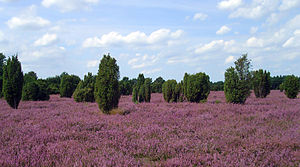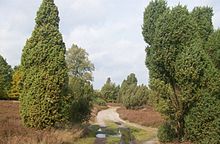Holy Grove (Gifhorn District)
|
Holy grove
|
||
|
Typical vegetation in the NSG |
||
| location | North-east of Gifhorn , in the Gifhorn district in Lower Saxony | |
| surface | 56 ha | |
| Identifier | NSG BR 022 | |
| WDPA ID | 81856 | |
| Geographical location | 52 ° 38 ' N , 10 ° 35' E | |
|
|
||
| Sea level | from 60 m to 77 m | |
| Setup date | 10/03/1952 | |
| administration | NLWKN | |
The Heilige Hain is a 56.16 hectare nature reserve near Betzhorn in the municipality of Wahrenholz in the north of the Gifhorn district in Lower Saxony . Many tourists visit the area especially when the heather is in bloom.
history
The heather farming in the area of today's Holy Grove, which was operated until 1913, had left an extremely nutrient-poor area. The land was practically only suitable for keeping heather sheep , which by eating the tree saplings ensured that the vegetation that is characteristic to this day consisted of tall junipers and wide heather areas. In 1913, a small area of 2.5 hectares in the heather area was placed under nature protection and thus preserved from the cultivation that was customary at the time. Only sheep pasture was allowed in the protected area. In May 1913 it was opened to the public as a recreation area with the original cultural landscape of the Lüneburg Heath . The name was not given unanimously: a Hamburg painter suggested the name Heiliger Hain based on a well-known landscape painting by the Swiss painter Arnold Böcklin . This designation was not in line with the previously common field names Garskrempel or Gaen Krempel. Hermann Löns , who was inspired by the heathland for his story “Der Quellbrink”, fought in vain for the name of the area with the historically guaranteed field name. Over the years the protected area has been expanded to its current size of around 56 hectares.
particularities
The Heilige Hain is one of the largest heather areas in the Gifhorn district. It is located on the slope of the Könnschiersberg, a ground moraine slope at 80 m above sea level, and runs down to the valley of the Oerrelbach. The area is criss-crossed by numerous hiking trails. It has a typical heather landscape, which is divided into drier and more humid zones. The vegetation is accordingly different, but in the plant communities it is typical for a foothill of the Lüneburg Heath. On the dry sandy heath next to the typical heath plants such as find heather and juniper, for example, bell heather and various broom . Moist heather is also available. There is also a small forest of pine, spruce, oak and birch in rustic growth forms.
The animal world is represented by adders , blindworms , fence and forest lizards as well as numerous insects such as sand bees and butterflies .
In the north of the area there has been a memorial stone since 1984, which commemorates the heath poet Hermann Löns. In 1912 he lived in nearby Wahrenholz for two months . The only building in the nature reserve is a sheepfold, which was used until the 1950s and which probably dates from the 17th century and is now a listed building.
48.15 hectares of the area are in the FFH area Rüssenbergheide - Külsenmoor, Heiliger Hain.
Problems
Due to the lack of heathland management and the increasing input of nitrogen with its eutrophic effect due to air pollution , it is becoming increasingly difficult to maintain the character of the heather landscape. Maintenance measures such as removing young deciduous trees and plowing the heather are therefore inevitable. In addition, the numerous visitors to the Holy Grove have a negative impact on the existence of the area, for example through erosion on the roadsides.
Between 1981 and 1983 there was a mass reproduction of the heather leaf beetle , which temporarily severely damaged the heather.
literature
- Joachim Bäter: Heiliger Hain , in nature reserves in the Gifhorn-Wolfsburg area . Großkopf-Verlag, Wolfsburg 1986, ISBN 3-929464-00-4 .
- Ernst Andreas Friedrich : Designed natural monuments of Lower Saxony , Landbuch-Verlag, Hanover 1982, ISBN 3-7842-0256-X .
Web links
- "Heiliger Hain" nature reserve in the database of the Lower Saxony State Office for Water Management, Coastal and Nature Conservation (NLWKN)
- Ordinance of the district of Gifhorn from 2013, pp. 12–30 (PDF)
- 360 ° panorama , Südheide Gifhorn
Individual evidence
- ↑ a b c Ordinance of the district of Gifhorn from 2013, pp. 12–30 (PDF, 6.9 MB), accessed on August 24, 2014.
- ^ Hermann Löns und der Heilige Hain , Samtgemeinde Wesendorf, accessed on February 2, 2015.





